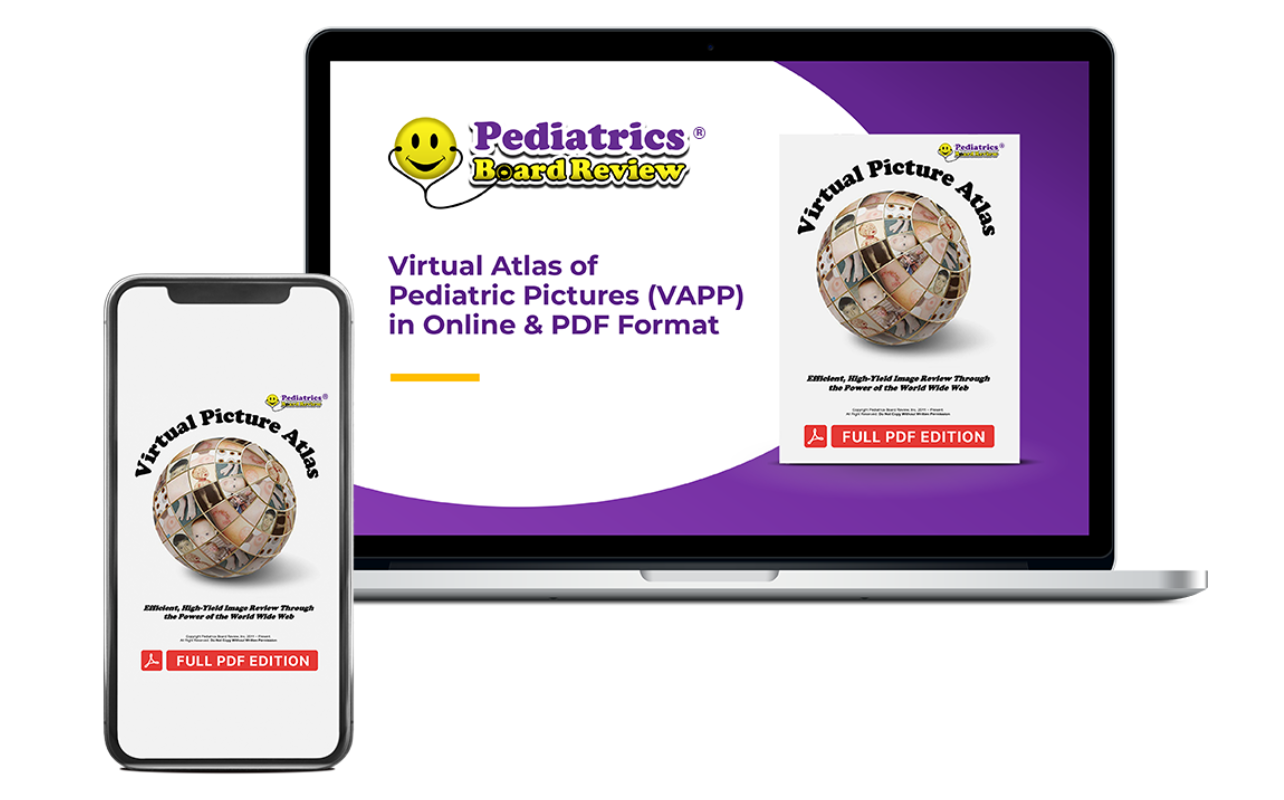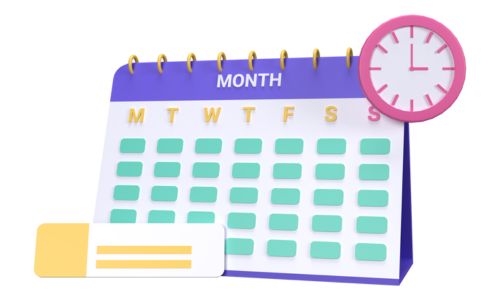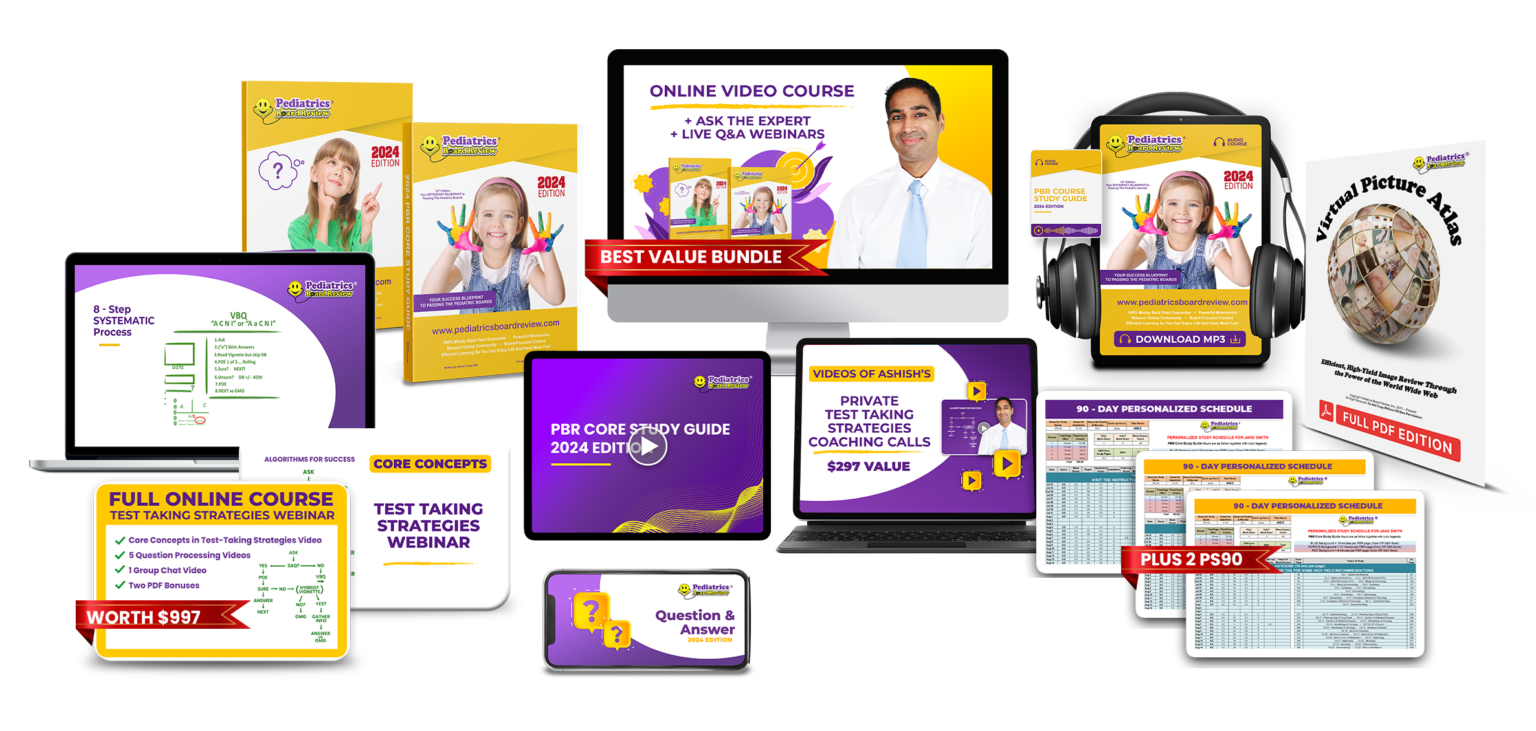The Pediatric Boards Pass Rate Could be 100% This Year!
I Know You Don't Believe It, But It's TRUE!
The pediatric boards pass rate had been horrendous for years. BUT, after a very long time, the American Board of Pediatrics (ABP) finally decided to make some long-needed changes in 2012. In the prior years, your grade was essentially determined based on a curve. The curve was meant to ensure that 20-25% of first-time test takers failed the pediatric boards resulting in a pediatric board pass rate of about 75 – 80%. So, your chances of success were determined by the mix of your peers. If your peers were smarter than you, that meant you were more likely to fail!
The ABP's Updated Method of Grading
Now, the ABP has simplified the grading process. You will be given a passing score based on the same grading systems used in elementary schools. If you get more than a certain number of questions correct, you pass. That's it! Click Here And Continue Reading…
Pediatric Board Review Course 2024
PEDIATRIC BOARD REVIEW COURSE 2024 (14TH EDITION)
Introduction
In this article, we’ll learn about pediatric board review courses being offered in 2024 and learn why live courses are broken. We'll also be sharing resources and recommendations for those looking into live board review courses, along with a review of the 2024 pediatric board review course created by the Pediatrics Board Review (PBR).
PBR was created by me, Ashish Goyal. As a pediatrician, I excelled when I increased my score by 160 points on the American Board of Pediatrics (ABP) Initial Certification exam. I was then asked by the ABP to write questions for them.
Now, as an author, my mission is to provide the best pediatric board review materials to residents and pediatricians. And I’ve been doing this successfully with PBR since 2011.
Test Taking Strategies
As physicians, we're trained to learn “everything” in our field, and we apply the same methodology to how we prepare for an exam. We start from the first sentence and take a top-to-bottom approach.
But these strategies do NOT work when you are studying for the pediatric boards.
That’s why at Pediatrics Board Review, we focus on creating a full, one-stop shop for you to focus your learning on three things. They include:
- The specific topics that will be tested on the exam.
- The strategy behind test taking, and how to deconstruct difficult questions with ease.
- The tools, schedules, and systems needed to promote efficiency and accountability.
This article will cover a LOT about what pediatricians just like you need to pass the pediatric boards (and how we have been providing that successfully for the past decade).
The system that we’ve created has been proven to be much more effective (and cheaper) than attending a 4-6 day long course where you're expected to learn everything about pediatrics. And if the thousands of happy pediatricians are any indication, using the PBR Certification Methodology is the way to go (but more on that later). If you are set on finding a traditional, live pediatric board review course, we do offer some advice and resources to help. Keep reading below to find a list of companies we've compiled that are offering live pediatric board review courses and the cost of attending. But, if you have 5 minutes, take the time to read this article because it will likely save you time, money, and energy.
2024 Pediatric Board Review Course
Through this article, and videos like the one below, you will begin to quickly understand why a “traditional” pediatric board review course can lead to failure. PBR is not a traditional board review company, and we focus on helping physicians in ways that have never been done before. In the video below, I share with you the arrival of the new edition of the PBR Core Study Guide, the Question & Answer books, our Test-Taking Strategies Course, and information about the differences between PBR and other board review courses that allow us to excel at what we do.
So hit the “play” button below and watch this book “unveiling” video to get an excellent understanding of what makes PBR different than any other medical board review program.
Click here to get the full Pediatric Dermatology and Pediatric Gastroenterology chapters from THIS YEAR's EDITION of the PBR so that you can TRY BEFORE YOU BUY!
THE MAKINGS OF A GREAT PEDIATRIC REVIEW COURSE
What Makes a Great Pediatric Board Review Course?
Having been around pediatric board materials (and helping pediatricians pass!) for more than 10 years, I have found the key to any successful pediatric review course which boils down to 5 key elements:
CONTENT CONGRUENCY
Having materials that work cohesively together has been proven to better reinforce knowledge in our brains. This is compared to having several disjointed study materials with competing methodologies. Congruency promotes a smarter, not harder, studying experience.
BOARD RELEVANT MATERIAL (NOT ALL MATERIAL!)
No course should try to shove as many topics as possible into your brain; that will only lead to overload! Pick a course that provides a laser focus on the topics that are known to be tested, and curates your study experience around those topics.
A FOCUS ON THE TEST-TAKING STRATEGY (JUST AS MUCH AS THE TOPICS)
Everyone has a colleague, a friend, or a family member who is very intelligent but tests poorly. When it comes to standardized tests, knowing how to test is just as important as knowing about the subject being tested! So, your chosen course should place a high emphasis on teaching you how to TEST well.
INTERACTION
A course that promotes interaction with both your peers and the instructor can lead to a better study experience. Trying to study in isolation for hours on end, with an instructor just talking at you, will only limit the amount of information you retain. It will also provide zero opportunity for you to gain clarification on the difficult topics you struggled with.
MULTIPLE RETENTION TECHNIQUES
Everyone learns at a different pace, so finding a course that utilizes several retention techniques to help you solidify what you are studying is key.
It was after working with several pediatricians on their board exams that I started to realize that there was a major gap in the medical education field that covered all 5 elements, and pediatricians were suffering the most because of it. This is why I created the PBR Certification Methodology over 9 years ago, and why it is at the core of everything that PBR offers.
A PEDIATRIC BOARD REVIEW COURSE WITH A 100% MONEY-BACK FIRST-TIME PASS GUARANTEE
What is the PBR Course?
The PBR's 2024 pediatric board review course offers you a complete SYSTEM. We not only teach you about the pediatric topics you need to know for the boards, but we also teach you test-taking strategies and Deep Study techniques to ensure you have the BEST chance at passing your pediatric board exam. We also provide a peer group for educational support.
For the 2024 American Board of Pediatrics initial certification exam, maintenance of certification (MOC) exam, and MOCA-Peds assessment, here are a few of the reasons that pediatricians prefer PBR:
- You learn more than enough pediatric content to get a score that is ABOVE the national average.
- You understand the reasons to AVOID pediatric “board review questions” as a source of learning.
- You learn about test-taking strategies that allow you to answer board questions quickly and accurately (even when you're not fully knowledgeable about a topic).
- You learn to create a streamlined study schedule to prepare for the boards that will liberate you from the confusion and overwhelm that you're currently experiencing.
- You learn how to prepare for each of these exams efficiently.
The PBR Certification Methodology Includes…
The Clarity Expander
One of the toughest obstacles to overcome while studying for the pediatric boards is clarity. This means having a firm understanding of what you do (and do not) need to know in order to pass. For example, did you know that the AAP PREP questions are NOT the best study questions? Or, that you should NOT try to study every single topic laid out in the American Board of Pediatrics content outline? Or, that if you failed last year, you should NOT tailor your studies to address low scores from your score report? PBR’s system is the only proven system to help you gain clarity on these nuances so that you study smarter, not harder!
The Retention Maximizer
Maximize your chances of content retention through common sense explanations, innovative “DOUBLE TAKE” topics that are repeated throughout the Core Study Guide, PBR “PEARLS” that are almost guaranteed to show up on the exam, story-based mnemonics, and concise content.
The Repetition Amplifier
Utilizing a multimodal approach to studying through hardcopy books, online videos, downloadable MP3s, mobile access, an online picture atlas, and other creative techniques allows you to review the same core materials in multiple ways. By promoting studying via multiple modes, our system encourages deeper learning to help you while studying for the pediatric boards! The Strategic Approach: Learn Test-Taking Strategies that allow you to systematically approach, process, and answer board-style questions on standardized exams. There are rules that you can learn to help you “beat the boards” and pass your exam. There is also a structured approach to processing every single board-style question in order to make the experience error-free and robotic.
The Network Experience
Do NOT study in isolation. Utilize the support of hundreds of pediatricians in the PBR Discord Community to help you quickly answer your board review questions. You can also work with Team PBR to create a study schedule specifically designed for you, and you can attend live webinars with content experts to help blow past complicated questions that are slowing you down. Just press the “ASK THE EXPERT” button. Then, you can focus on your studying while we do the research. Again, you should not have to do this alone, and the PBR community is here to support you.
WHY WE DON’T OFFER A TYPICAL, LIVE PEDIATRIC BOARD REVIEW COURSE
Why Typical, Live Pediatric Board Review Courses Won’t Work in 2024
Beyond the fact that they are incredibly expensive, the typical live courses are not set up to give you a strategic study method to pass the boards. The entire system is broken. Here is a comparison chart for you to see the difference between a typical board course, and PBR:
Your TYPICAL Board Review Experience |
The PBR Board Experience |
|
|
Does the “typical” experience sound familiar? It definitely does to me because that's exactly what I did when I failed the pediatric board exam the first time I took it.
I was SHOCKED. But, I eventually uncovered multiple secrets to help me pass the initial certification exam and increase my score by 160 points.
Trial and Error
Then, through my many trials and errors, I created a SYSTEM that has gone on to help so many pediatricians pass the exam.
This system has not only helped first-time test takers pass the boards on their first attempt; it has helped high-risk pediatricians FINALLY pass after multiple failed attempts. Every year, we get tons of testimonials from pediatricians that finally pass after as many as seven failed attempts!
PBR is about maximizing your learning experience through a proven system that helps you pass the boards.
For anyone who has failed the pediatric boards before, or anyone who has struggled to get above a 222 on the USMLE Step 1, our Test-Taking Strategies & Coaching course is a breath of fresh air. Also, while live courses that cover “all of pediatrics” are of little benefit, a LIVE, 2-Day Test-Taking Strategies Course is the most leverageable option to accelerate someone's understanding of the test-taking techniques and topics needed to become a test-taking NINJA!
THE MOST EFFICIENT PEDIATRIC BOARD REVIEW COURSE 2024 HAS TO OFFER
What are the Pediatrics Board Review (PBR) Resources?
At the center of the PBR system, you will find the Pediatrics Board Review Core Study Guide and the Pediatrics Board Review Q&A book. We focus on the idea of having congruency across all of our resources. So, all of our pediatric study materials are born from these two resources. This is done so we can help you get the repetition and reinforcement needed as you go from one PBR resource to another.
PBR's CORE STUDY GUIDE
The PBR Core Study Guide is your content Bible. No more buying 3-4 different study materials to hodgepodge a study schedule together. We have done the curation of content for you! If it's not in your PBR Core Study Guide, then YOU DON’T NEED TO STUDY IT.
- Offered in hardcopy and online formats
- Contains a Success Blueprint and Roadmap to Success which tells you exactly how to use the PBR resources
- Has a strong focus on testable and tested topics
- Includes hundreds of time-saving story and image-based mnemonics, along with other memory aids
- Contains online systems that allow for one-click access to HUNDREDS of high-yield images across the web
PBR's QUESTION AND ANSWER (Q&A) BOOK
This is NOT like other question banks. This is valuable, high-yield content that's just as valuable as the PBR study guide and should be used as part of your core content review. Use OTHER pediatric prep questions for PRACTICE. KNOW the difference between what to study versus what to use for PRACTICE.
- Available in hardcopy and online formats
- Extremely high-yield questions and answers
- Contains detailed explanations and excerpts from PBR's Core Study Guide
PBR's ONLINE PEDIATRIC BOARD REVIEW VIDEO COURSE (OVC)
Get the value and insight of a live conference from the comforts of your room. This is your “online version” of an in-person pediatric board review course, except you can take it ANYWHERE because it's compatible on your phone or tablet.
- Videos cover the entire PBR Core Study Guide and the PBR Q&A Book
- Live summertime question and answer webinars featuring content experts to answer all of your questions
- Online pre-webinar question portal which allows you to send in your questions as they come to mind
- Recorded webinars are available for replay
- Learn from board-certified PBR alumni
PBR's PEDIATRIC BOARD REVIEW AUDIO COURSE
Maximize your efficiency by taking the audio course with you to the gym, the grocery store, your car, or the mall.
- The MP3 course is available as a streaming OR a downloadable resource.
- Load the downloadable version onto your favorite MP3 player, or listen to it on your computer.
- Listen to the streaming version via your desktop or mobile device.
PBR's DIGITAL PICTURE ATLAS
PBR's Virtual Atlas of Pediatric Pictures (VAPP) offers a review of 400 of the most high-yield and board-relevant images QUICKLY, through the power of the web, without having to flip back and forth in your Zitelli.
- Accessible on your desktop, mobile device, or tablet
- Available in PDF or Online Format
- Access all of the PBR images in ONE place with reference posts available for review
- Quick access to the corresponding topic within the PBR study guide
PBR CORRECTIONS AND CLARIFICATIONS GUIDE
As With everything in medicine, things change. To make the PBR materials as error-free and up-to-date as possible, we use all of your suggestions and error submissions to create a Corrections and Clarifications guide.
Here are the benefits of the Corrections and Clarifications Guide:
- Receive updates in the world of pediatrics
- Review a detailed list of corrections to our materials
- Obtain an advanced look at NEW content that is going to go into the next edition
- Get answers to questions that you have submitted to us for review or clarification
PBR's DISCORD COMMUNITY!
A critical component to the success of so many pediatricians is PEER SUPPORT! Without it, your efficiency and your drive to study can plummet. The PBR Discord Community is a pediatric board review forum that is exclusively for PBR members.
The forum allows you to:
- Ask questions about topics that are confusing you.
- Share mnemonics and insights of your own.
- Get educational and emotional support during one of the most stressful times of your life.
- Increase your EFFICIENCY by leaning on others to answer your questions instead of going to the black hole of Google.
PBR's TEST-TAKING STRATEGIES
“Test Day” can be a terribly stressful time for the pediatric board exam. The key to avoiding test anxiety is to:
- Have a solid foundation of knowledge.
- Make the process of answering questions almost mechanical.
Your board exam is like a GAME with rules that CAN be learned. There are strategies you can learn to master your question-answering technique. Through PBR's ONLINE Test-Taking Strategies & Coaching courses, you quickly learn how to identify answers EFFICIENTLY, leaving you with time to spare. The online course is a MUST for everyone taking the Initial Certification exam, even if you are attending our Live Test-Taking Strategies & Deep Study Course
PBR's COACHING AND MENTORSHIP
If you've ever struggled with any medical board exam in the past, or if you did not score above 222 on the USMLE Step 1 exam, we strongly suggest the Live Test-Taking Strategies & Deep Study Course. We've helped pediatricians succeed after NINE failed attempts. Imagine what this program could do for you.
- Learn how to answer questions with little knowledge on a given topic.
- Learn shortcuts that allow you to answer certain questions WITHOUT reading any of the vignettes.
- Learn why focusing on the ENGLISH (more than the medical concepts) can help you zero in on the correct answer choice when you're left with those final two options.
- Get the Core Concepts in Test-Taking Strategies Webinar to learn the fundamentals of test-taking strategy.
- Get 5 QUESTION PROCESSING webinars to go deeper into advanced test-taking strategies as you learn to process questions systematically.
- Learn shortcuts, including what it means to have answer choices that are either very similar or complete opposites.
- Learn techniques to address problems with diet, anxiety, insomnia, and test-day fatigue.
- Get help creating your own test-day schedule. Learn what to do during your breaks, what to eat, what NOT to eat, how to remain as energized at the end of the exam as you were at the beginning of the exam, and much more!
THE LIVE 2024 PEDIATRICS BOARD REVIEW TEST-TAKING STRATEGY COURSE
In addition to the online courses, I also offer live training to teach you test-taking strategies to help you pass the pediatric boards.
Compared to the online courses, the Live Pediatrics Board Review Test-Taking Strategy Course gives you a unique experience to get your questions answered and tailored to you. If you scored as high risk on the PBR Risk Calculator, this course would be the best way to ensure a pass on the boards.
PBR is the first medical board review company to offer a comprehensive course on test-taking strategy and “deep learning.” We have helped pediatricians become MASTER test-takers so that they can increase their chances of passing the boards exponentially. And with our new, Zoom-based live course, the live course can be attended from the comfort of your home without the expense of travel or lodging. Be sure to check our live page to see when both the in-person and Zoom courses are available.
ALL OF THE PHYSICIANS BELOW PASSED AFTER GOING THROUGH THE TEST-TAKING STRATEGIES COURSE
Click here now and learn more about the 2024 Pediatrics Board Review Live Course On Test-Taking Strategies & Deep Study.
A COMPREHENSIVE SYSTEM TO HELP YOU PASS THE BOARDS IN 2024
The “No Brainer” Package: Everything You Need to Pass the Initial Certification Exam
PBR was created to help others avoid failure and frustration. Pediatricians get frustrated about overwhelming and incongruent resources, and overwhelming costs.
PBR has been part of the solution by pioneering newer, faster, and more effective strategies to educate pediatricians. The Online Video Course, the Virtual Atlas of Pediatric Pictures, the live summertime webinars, and the members-only Discord support area are just a few ways we've changed how doctors think about board review.
I want you to focus on the CONTENT, the COMMITMENT, and the TECHNIQUE needed to pass the boards.
Not the chaos around multiple resources, or the expense related to a resource that could be helpful.
That's why we recently created the No Brainer package and VIP Bundle.
Our No Brainer bundle includes 100% of our multimodal content-based resources to help you build your fund of knowledge. It also includes the option to have Team PBR create up to three 90-Day Personalized Study Schedules specifically for you to help with accountability and commitment. It also includes our Full Online Test-Taking Strategies Course to help you with your test-taking technique. All for less than the cost of a single board review video course.
But, stop thinking about money and start focusing on what you can do to pass the boards. Get the access you need for less than the cost of any major pediatric board review video products on the market.
No Brainer Bundle
It's what you “should” get for the Initial Certification exam. Learn the pediatric content AND the test-taking strategies to pass. Plus, get up to 3 Personalized Study Schedules created by Team PBR.
12 Months of Access
- Core Study Guide in Hardcopy and Online Formats
- Q&A Book in Hardcopy and Online Formats
- MP3 Audio Course in Downloadable and Streaming Formats
- Pediatric Picture Atlas in Downloadable PDF and Online Formats
- Online Video Course Covering All 31 PBR Chapters
- “ASK THE EXPERT” Question Portals for All 31 chapters
- Live Q&A Webinars with Content Experts for All 31 Chapters
- Test-Taking Strategies Core Concepts Webinar
- Test-Taking Strategies FULL Online Course
- A 90-Day Personalized Schedule created by Team PBR Based On Your Work Schedule, Pace of Reading, Risk Profile & Much More
- 2nd 90-Day Personalized Schedule
- 3rd 90-Day Personalized Schedule
- Free Expedited Shipping
- Discord Community Access!
- 100% Money Back First-Time Pass Guarantee
WHAT PBR MEMBERS HAVE TO SAY
Dr. Zwiener
“Tears of joy are wonderful. No thank you could ever be sufficient for all the support and guidance from Ashish and PBR over the past couple of years. Ashish who truly cares and believes in each individual person and helps guide them. I honestly used to laugh at the people who said they improved by 30 or more points, didn't think it was possible. It’s more than possible with PBR and can't thank Ashish enough! I failed each of the past 3 years not even getting within 5 points of passing.
I never ever thought of quitting or giving up, but I went all in with PBR including the core study guide (8X!!), all access pass including the videos and audio, live test taking strategies course and a 2 hour 1-on-1 session with Ashish after having a moment of revelation. LISTEN to this man. Follow his advice word for word. I finally PASSED on the 4th attempt! I improved my score by 42 points!!! It takes an army to go through this. I had to sacrifice being with my family, but we did it together. I hope and pray everyone reading this that's ever failed or struggled with test taking in general to not give up hope. It can be done. Cheers!”
Dr. Russell Zwiener Board Certified Pediatrician (2018 Member)
Dr. Yessenia
“Ashish, I did it. I can't thank you enough for creating an amazing system to keep me on track with my studying… the live weekend test taking course was well worth it. Doing the technique during the test kept me focused and allowed me to eliminate wrong answers. Thank you for all the great advice, sticking to the material, memorize, memorize, memorize then practice practice practice. After 4 failed attempts it was exhilarating to finally read the words, “we are PLEASED to announce you PASSED!” I will definitely recommend your program.”
God Bless
Dr. Yessenia Castro-Caballero: Board Certified Pediatrician All Access Pass Member Live Test-Taking Strategies & Deep Study Course Attendee4 Prior Failed Attempts
Dr. Johnson-Clark
“I am an intelligent driven pediatrician who took her Boards for the first time because her job paid for it and told her to “see what it was like.” No studying – just walked in and took it. And failed – shocking at the time – not shocking now.
The second time I took my boards –
I studied – I used multiple sources – and I failed. Scoring is the same as the first time. Again – what the hell happened?
The third time –
I took a Board Review Course in Washington DC and stuck with Cleveland Review. I practiced questions – but not enough (I know that now). And I took the test again – and failed by 10 points. I was in shock –
The fourth time –
I found PBR – I loved it. I practiced questions (thousands – but no AAP or Medstudy – just board vitals and exam master), I took the online PBR test taking strategy course, and I failed – by 4 points. Again shock set in.
I mustered up the courage to take it again.
I met with you to dissect where I went wrong and came to Atlanta, and then I followed your advice – even though sometimes I didn't like it 😉 You encouraged me to get my eyes checked (double vision issues that I never truly addressed except with thicker prisms) and recommended Frannie. Then my world changed – not only with respect to passing my boards – but my actual life – My vision was a disability that I had been living with for years and I didn't even realize it.
The doctor I met for vision therapy (where I felt skeptical at first) showed my what my world was missing. My visual fields were so restricted I was tunneling my vision. I was reading with only intermittent use of my left eye (my brain was shutting it off bc of the doubling). My comprehension on questions was limited and I had to read and reread questions to simply understand them. I started visual therapy and it has been life-changing. And I have you to thank for your perseverance and support. I have God to thank for aligning our paths. And I have Frannie to thank for the nudges phone calls and emails of encouragement.
Thank you, Ashish – for changing my world – you are meant to continue PBR for those smart physicians who are being belittled by an organization that is meant to support us. Thank you for the Atlanta class – I met the most amazing study partner and we both passed – Just thank you! I would love to have the opportunity to help you with PBR if you are looking for physicians… We can only be stronger together.”
Kate Johnson-Clark Board Certified Pediatrician (2018)
All Access Pass Member
Personalized Schedule User
Live Test-Taking Strategies & Deep Study Course Attendee
4 Prior failed attempts
Dr. O
“Ashish I passed!! I passed. After so many many attempts.
I am thankful for your team. For the personalised schedules… and how will I forget the Atlanta test-taking strategy course?.
Aside from the fact that a lot of your strategies were eye opening and super helpful, it hit me that I was not alone. Through the years of depression, of doling out money for the exams and the near-passes (few pts below 180), I found some strength to believe that I wasn't dumb and that I could pass!. And I drew strength from the fellow attendees that day, and from you Ashish. You believed we could pass!!
I could go on and on. You have NO idea how the yrs have been for me. I only know it was my faith in God that kept me going, determined to get to this. My husband has been such a solid, solid rock beside me through this. He's right there , sometimes just listening on those nights when I'll cry and wonder; where did I go wrong?, what am I doing wrong every year? Am I soooo poor at test taking?…..
Let me just stop by saying THANK YOU Ashish for what you do.
Please keep doing it. People may say; well he makes money for it. But no dear, that sacrifice of your time, the passion you bring with each teaching session and webinar, the constant unwavering faith in those you mentor……. NO you don't put a price tag on that!
For that I am grateful. You make an impact in people's lives.
Please do say thanks to your entire team as well.
I thank God for bringing PBR my way.”
Dr. O. E. Board Certified Pediatrician Live Test-Taking Strategies & Deep Study Course Member 6 Prior Failed Attempts
Why PBR is the Top Choice for Pediatric Board Review
Everything I’ve mentioned above is just a small overview of why PBR is again the most popular pediatric board review course in 2024. I’m so excited for all the new members currently studying with us, and can’t wait to see how many new board-certified pediatricians we have come October. If you're not a member yet, what are you waiting for?
No Brainer Bundle
It's what you “should” get for the Initial Certification exam. Learn the pediatric content AND the test-taking strategies to pass. Plus, get up to 3 Personalized Study Schedules created by Team PBR.
12 Months of Access
- Core Study Guide in Hardcopy and Online Formats
- Q&A Book in Hardcopy and Online Formats
- MP3 Audio Course in Downloadable and Streaming Formats
- Pediatric Picture Atlas in Downloadable PDF and Online Formats
- Online Video Course Covering All 31 PBR Chapters
- “ASK THE EXPERT” Question Portals for All 31 chapters
- Live Q&A Webinars with Content Experts for All 31 Chapters
- Test-Taking Strategies Core Concepts Webinar
- Test-Taking Strategies FULL Online Course
- A 90-Day Personalized Schedule created by Team PBR Based On Your Work Schedule, Pace of Reading, Risk Profile & Much More
- 2nd 90-Day Personalized Schedule
- 3rd 90-Day Personalized Schedule
- Free Expedited Shipping
- Discord Community Access!
- 100% Money Back First-Time Pass Guarantee
A Pediatric Board Study Schedule with Step-By-Step Instructions
Why You DO Need A Study Schedule for the Pediatric Boards
Introduction
Developing an effective Pediatric Board Study Schedule is crucial for success in the pediatric boards. In this article, we'll outline a comprehensive strategy tailored to your needs, whether you're juggling a busy practice or an unpredictable fellowship schedule.
I often get asked questions along the lines of…
“Can you give me a general pediatric board study schedule?”
“I'm in practice and very busy. Can you provide me with a pediatric board study plan that's going to work for me?”
“Can you provide a pediatric board study schedule for those of us with an erratic schedule because we're in fellowship?”
The answer to all of these questions is “yes.” But, when you’re preparing for your pediatric board exam, the most essential first step is to map out a dedicated amount of time for your studying based on your personal availability and the recommendations in this article. If you are a first-time test taker, and you:
- Graduated from a US medical school
- Have done well on prior board exams
- Scored above 222 on the USMLE Step 1
- Come from a residency program with a high passing rate, and
- Have done well on your most recent In-Training Exam
Then you are likely at low risk for failing the pediatric boards, and this is the study plan for you! For low-risk test-takers, I recommend finding a MINIMUM of 300 hours to block out in your schedule, with plans to go through your Pediatrics Board Review material at least THREE times.
Click Here Now & Go Through the Full PBR Risk Calculator
Pediatric Board Personalized Study Schedule
Please remember, though, that a schedule is only as valuable as your DETERMINATION to follow it. In this article, I break down those 300 hours into a manageable, concrete schedule that you can use to guide your studies and PASS the pediatric boards.
Since it’s impossible for me to know exactly what your commitments are, what I’ve tried to do below is map out 14 weeks of study time based on the goal of studying approximately 300 hours.
Even if you do not agree with everything I recommend, keep reading to get some ideas that you can incorporate into your own board preparation plan. At the end of this article, I also share some pearls of wisdom to help you manage all of the study time that will be needed to pass your boards!
What If I'm at “Moderate to High Risk” of Failing the Pediatric Boards?
If the risk calculator helped you realize that you are at moderate or high risk for failing the boards, don’t worry! I've created a 16-week study schedule to help you succeed on the boards! The recommendations in the other article are tailored towards graduates who were told that they were “at risk” of failing the boards based on their in-training exam scores, and those who have already failed the boards at least once.
What Should I Review to Pass the Pediatric Boards?
In this article, we will reference PBR’s core content for the studying resources, which refers to the PBR’s Course Study Guide and PBR’s Q&A book. We strongly recommend that you review your board materials using a multimodal approach. Doing so has proven to increase learning retention. The different modalities should be congruent; they should all work well with each other to reinforce your knowledge base. This strategy has helped thousands of pediatricians pass the boards – from first-time test takers to those who have failed up to 7 times.
While these two books are what we use in this study schedule, the most common bundles that our members use are the All Access Pass and the No Brainer. The All Access Pass includes:
- PBR’s Core Study Guide (Hardcopy and Online Editions)
- PBR’s Question & Answer Book (Hardcopy and Online Editions)
- Virtual Atlas of Pediatric Picture (Online and PDF Editions)
- Audio Course (Streaming and Downloadable Editions)
- Online Video Course
- Live Summertime Q&A Webinars
- And more…
The No Brainer includes everything in the All Access Pass, but it also includes:
- PBR's Full Online Test-Taking Strategies Course
- Personalized Study Schedule creation services by Team PBR (up to 3 schedules)
Click here to get the full pediatric Dermatology and pediatric Gastroenterology Chapters From THIS YEAR's Edition of the PBR. “Try Before You Buy!”
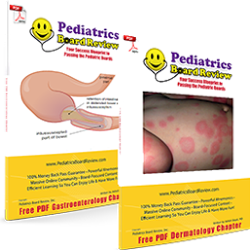
A Pediatric Board Study Schedule For First-Time Test Takers
This comprehensive pediatric board exam study plan is based on committing to an average of 23 hours of studying per week. If you follow the schedule below, you will go through the PBR materials three times, and answer over 500 practice questions. If you stick to the plan, you’ll be done in 14 weeks or LESS (based on your personal life commitments).
A successful study schedule is comprised of both learning and application. Which is why this article will focus on helping you go through the PBR materials and practice questions. I usually recommend AAP PREP ® questions. Below you’ll find a guide that breaks down how you should consider spending your time.
When you go through AAP PREP ® questions (I recommend going through about 3 years of questions), you should NEVER get bogged down with any individual question. Those questions should only be used for practice as I’ve mentioned in the article titled “How Many AAP PREP Questions Should I Do?”
Spend a maximum of 5 minutes on each question. That's 75 seconds to answer each question, and then no more than 3.5 minutes to review each answer. That comes out to about 40 hours of practicing questions. Approximately 240 hours will be spent going through PBR's “core content,” with 20 hours of buffer time to account for additional content review, additional questions, and even mock exams.
What If My Board Exam Is Less Than 8 Weeks Away?
If you have less than 8 weeks, it is still possible to use this schedule. Think of the study schedule as a guide. This outline was created based on the assumption that most people would begin studying at least 14 weeks prior to test day.
If your exam is less than 8 weeks away and you have just started your board preparation, then you will need to study approximately 37 hours per week in order to reach the 300 hours mentioned. We've helped pediatricians pass their board exams even when they waited until the last 4-6 weeks to study! But you must be committed to adjusting your personal and professional obligations in order to put the time in.
And if you need some additional help to stay on track, visit the Discord Channel and find an accountability partner! Or, reach out to Team PBR to see if we are currently offering our Personalized Study Schedule creation service.
Highlighter Study Tip for Passing the Boards
One final tip before you dig into the schedule! This is a great highlighter trick that I teach my PBR members as a focus tool. If you can master this, you will have a more efficient board preparation experience.
For each round of the material, you highlight (or underline) only the areas you are interested in reviewing again. If it feels like you know a topic well enough to recall it on the day of the exam, don’t highlight it.
First, start with your lightest color. Then, with each read through thereafter, use a slightly darker color to highlight sections that you want to review again.
Here are my suggested colors to highlight with each read:1st Round: Pale Yellow2nd Round: Pale Pink3rd Round: Pale Orange
For your first pass, you may end up highlighting 80% or more of the book in yellow. By the time you start your 3rd pass, you should only have to read the areas you highlighted in pink, which could be as little as 30% of the books. In your final weeks, you can focus on just the areas that you highlighted in orange and go through that material again and again.
This will allow you to curate your studying to focus only on items you DON’T understand, as opposed to continually spending time on topics you understand well.
Now let's get started with more details on each week of this 14-week study schedule!
PEDIARTRIC BOARD STUDY SCHEDULE: WEEK #1 – WEEK #6
These first six weeks are all about getting a deep understanding of the materials. Go through PBR’s core content (the Core Study Guide and the PBR Q&A book) at a pace of 18 minutes per page. Take 6 weeks to do so and allot 120 hours in your study schedule for this (20 hours each week).
Cross-check facts, create mnemonics, and make notes in the margins so that you never have to go outside of PBR for additional knowledge or clarifications, and pay close attention to challenging areas. Aim for an average of 18 minutes per page within the two PBR books.
Break up your studying with an average of 5 AAP PREP ® questions per day as directed by PBR. Aim for 5 min per question (including the review of the answer). Over these six weeks, you should complete 210 questions. Questions will take about 3 hours of your time each week.
Listen to your audio board review course EVERYWHERE. Listen during your commutes, listen at the gym, and even listen in the shower. Save the video course for later.

PEDIATRIC BOARD STUDY SCHEDULE: WEEK #7 – WEEK #10
Since you have gone through the material in painstaking detail once, this round will be much faster! At most, you will need about 80 hours over the course of these next four weeks to go through your core content. Aim for an average of 12 minutes per page as you go through the PBR core content and try to only highlight/underline areas that you think will need more review and repetition.
Break up your studying with an average of 5 AAP PREP ® questions per day as directed by PBR. Aim for a maximum of 5 min per question, including the review of the answer. By the end of week 10, you will have completed a total of 350 questions in 12 hours (3 hours per week).
Since you will need 80 hours to review the core content and 12 hours spent practicing questions, you will again need to block off 23 hours per week (92 hours divided by 4 weeks is 23 hours/week). Again, listen to your audio board review course EVERYWHERE. You can choose to build in the Online Video Course during this round, or the next (it follows our core content almost EXACTLY).
PEDIATRIC BOARD STUDY SCHEDULE: WEEK #11 – WEEK #14
The Final Round of Core Content Review
Stick to the schedule and stay disciplined! You should now have a strong foundation of pediatric knowledge and your goal for these four weeks should be to complete your last round of PBR's core content. This final round of review should focus on helping you refresh your memory of familiar topics, and finally cement your knowledge of the difficult ones. For this reason, I recommend that you rely on the Online Video Course heavily during this time.
The Online Video Course is approximately 26 hours long and it covers the core content at a pace of approximately 4 minutes per page. This schedule has budgeted an additional 6 minutes per page for this final round so that you can use the Online Video Course with your Core Study Guide. So pause where needed, and take your time.
To be clear, you must read along in your hardcopy books as you watch the videos in order to count this as one of your 3 rounds of review. This multimodal way of preparing will ensure that you:
- See the highlighted content that you struggle with most
- See the slides in the videos
- Hear a board-certified pediatrician teach you the material that you've been reviewing for 10 weeks, but in a slightly different way
- Force you to review 100% of the content, including anything that you think you know very well and might have otherwise skipped during this crucial time leading up to the boards. And, this system will ensure that you…
- Pass.
Maximizing Final Study Days
Continue to actively read through the core content (take notes, make mnemonics, and continue to highlight using the above strategy). It's quite possible that you will have additional time to study in the final few days before the exam. If so, the content that you highlight during this round (in orange) will be the sole focus of your attention in those final days, and that content will be extremely beneficial for you. It's likely the material that you would otherwise struggle with on the exam.
Make SURE you know the PBR Core Study Guide and the PBR Q&A book inside and out. I simply can't stress this enough because this will be the key to your success! And if you are still uncomfortable with your knowledge base, then it's time to focus on “core pediatrics” that has not changed in the past 10 years.
Practicing Questions In the Final Weeks
The amount of time that you spend on questions during your 14-weeks of preparation can vary quite a bit. Understanding how to fully process a board-style question is a skill. Once you have mastered your test-taking technique, you only need to maintain that skill.
So if you feel like you're now an excellent test-taker, then you may only need to do a handful of questions per week in order to maintain your skill. But if you are still working on improving your test-taking strategy, you'll need to continue practicing questions daily.
When practicing questions, aim for a maximum of 5 minutes per question including the review of the answer. At this point, consider batching questions and doing at least 40 questions in a single sitting per week. Keep in mind that each block in the ABP Initial Certification exam contains over 80 questions, and that you should pace yourself at a pace of 75 seconds per question when answering the question. The remaining time of approximately 3 minutes and 45 seconds per question should be used to review the answers.
Where Do I Go If I Need Help?
The PBR system is designed to ensure that you do not have to do this alone. During this entire experience, you will have multiple ways of getting help.
- Reach out to fellow members of the PBR community in our private Discord channel with any questions or trouble spots. It's an extremely supportive area, and it's for members only.
- Reach out to our content experts using our ASK THE EXPERT! buttons within the Online Video Course and get your questions answered during our live, summertime Q&A webinars.
- Reach out to the PBR editor (and me) by submitting a content error, or a request for content clarification, through our dedicated page for error submissions.
- And if you're just confused about how to move forward, just email me and I'll see if I can point you in the right direction.
The system created by PBR is meant to provide you with a streamlined and supportive approach as you prepare for a very challenging exam. If you follow the advice in this article, you shouldn't need any outside resources to support your knowledge base.
Setting Up Your Pediatric Board Mock Exams
While studying is a crucial part of passing the boards, getting familiar with the test environment is just as important. That’s why I recommend that moderate to high risk test-takers go through at least two pediatric half mock exams before the actual test; one 6-8 weeks prior, the other 4-6 weeks prior. A mock exam allows you to not only test your knowledge thus far, but it also gives you a good understanding of how the very long day of testing will go.
Here are a few key tips to keep in mind if you decide to setup a mock exam:
- Use multiple question banks. Several people write questions for the boards, meaning every question has a different personality to it (I would know, as I have written some for the ABP). Getting familiar with the many different ways questions can be written ensures that you will not get blind-sided on test day!
- Recognize that taking a mock exam is about much more than your score. It’s about understanding the challenges and barriers that come with a very long day, and then optimizing your behaviors to ensure that you are the best version of yourself from the beginning to the end. Start working on your test day habits now, and replicate them on test day!
- If you need help setting up a mock exam, be sure to read our article on the exam structure of the ABP Initial Certification exam so that you can create a mock exam of your own.
You're Almost Done!
By the end of this 14-week study guide, you will have gone through 300 hours of board preparation. All by simply scheduling 23 hours of study time per week. If you are at low risk of failing the pediatric boards and you were able to push through and make the above happen, I have a Money Back First-Time Pass Guarantee that says that you will pass the pediatric boards.
At the end of the day, YOU must be the one to have the commitment and self-discipline. But, I can GUARANTEE that if you follow the study schedule outlined above, and couple it with a strong focus on test-taking strategy, you'll put yourself in an excellent position to pass the pediatric board exam.
By the way, if you are not a PBR member yet, then what are you waiting for?
The No Brainer package is the most common bundle used by our members to prepare for, and pass, the Initial Certification Exam. It provides you with a comprehensive and multimodal approach to studying. It also includes three 90-Day Personalized Schedules created by Team PBR and our Full Online Test-Taking Strategies Course.
Here is a list of everything you get in this very inexpensive bundle:
PBR’s Core Study Guide (Hardcopy and Online Editions)
PBR’s Question & Answer Book (Hardcopy and Online Editions)
Virtual Atlas of Pediatric Picture (Online and PDF Editions)
Audio Course (Streaming and Downloadable Editions)
Online Video Course
Live Summertime Q&A Webinars
Three 90-Day Personalized Schedules Created for You by Team PBR
PBR's Full Online Test-Taking Strategies Course
And more…
Pass the pediatric boards on your FIRST TRY.
Click here now and learn more about the No Brainer and our other proven products.
Are you still unsure? Download the entire Table of Contents, the PBR Roadmap to Success and the PBR Memory Pegs chapter absolutely free! Click HERE and download.
Failed Pediatric Boards? Find Success with Our Blueprint
If You Failed the Pediatric Boards, It’s Time to Study Smarter (Not Harder)
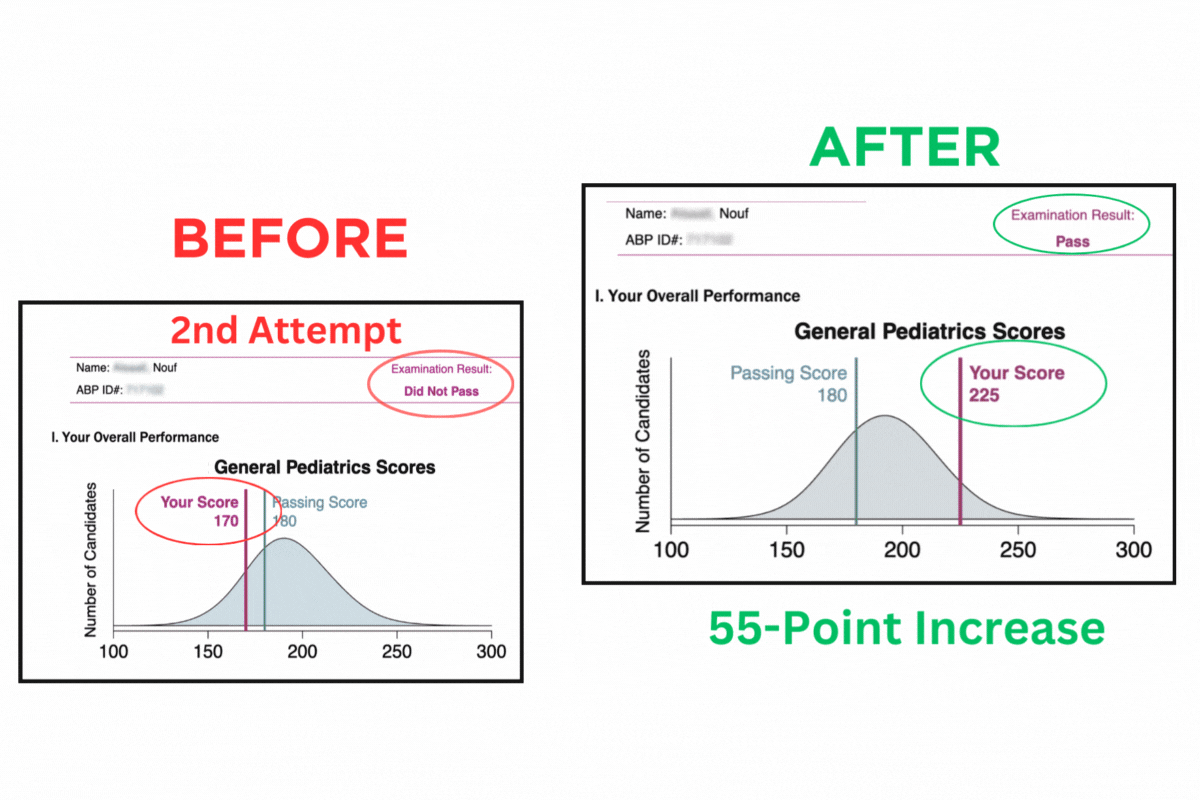
- Failing the boards doesn’t make you a bad pediatrician.
- Passing the pediatric boards will have more to do with having a comprehensive strategy than studying harder.
After failing the pediatric boards, your chances of passing decline by almost 50%. Having helped pediatricians pass the boards after as many as NINE prior failed attempts, I'm confident that you can increase your chances of passing with an effective study schedule and the right study guides in place.
What Do My Pediatric Board Results Mean?
There are a number of factors that led to your pediatric board examination results being less than 180. It could be due to 1 factor or it could be due to 10 factors. Meaning, that if you are only focusing on the board scores in isolation, you are likely to repeat your mistakes and fail again in the board exams. While you're familiar with some of the factors that can lead to success on your pediatric board exam, there are many that you probably haven't considered.
One important factor is creating a study schedule to ensure you cover all the necessary material. By following a study schedule, you can increase your chances of achieving high scores on your exam. These scores will play a crucial role in shaping your future as a pediatrician. Before you begin studying, consider all of the factors that could have led to your failure and strategize around them to create a comprehensive pediatric boards study plan.
Success Factors Related to Passing the ABP's Pediatric Exam
- Tailoring your study schedule is crucial for achieving high examination scores. Personalized preparation, with the guidance of mentors, can help mitigate the risk of failing the boards
- The pass rate of your pediatrics residency program is directly linked to the risk of failing your examination board scores
- Your USMLE Step 1 pass/fail scores in med school are related to your personal risk of failing
- Your in-training exam scores are related to your personal risk of failing
- Repetition of study content breeds reinforcement of difficult concepts
- Your available time and the density of your study materials will impact your ability to have repetition, which can greatly improve your scores
- Studying from multiple resources prevents repetition of your core resource and helps improve your understanding and scores
- Board review questions should be used to assess your test-taking strategy, not build knowledge
- Study sessions should be long and uninterrupted
- Multimodal studying at key points of your board preparation is crucial
- The ABP Content Outline and prior ABP score reports should not be the basis of your study plan
- Sleep hygiene should be excellent
- Personal, professional, and social obligations must be limited
- Distractions must be eliminated in order to have a “Deep Study”
- The time of day, when you study, is critical
- Abortive techniques for test-taking anxiety require practice
- Investment of time, energy, and money into success factors is required to pass
Study Schedule for Repeat Board Exam Test-Takers
This article outlines a detailed schedule that will help you pass the boards if you have failed the pediatric boards. Specifically, how to do so with materials that will help you (not fail you) during your next pediatric board exam. Remember, there are 3 pillars to passing the pediatric boards: Content, Test-Taking Strategy, and Commitment. Your failure(s) on the boards may have been due to a lack of knowledge or a lack of test-taking strategy. For most people reading this, failure was a result of a combination of both. For many, the commitment to spend the time, energy, and money to help secure the pediatric knowledge and test-taking strategy needed to pass the exam was also a major contributor.
The 16-week schedule provided below will give you the pediatric knowledge that you need to pass the boards. For help with test-taking strategy, poor attention to detail, falling for traps on the board exam, challenges with pacing, and problems attaining high-quality studying, the PBR article on test-taking strategy is a must read.
Throughout this study schedule, you’ll find references to the AAP PREP® series of questions. Note that while those questions are well-structured and thorough, you should use multiple question banks this year. Use each question to help you develop, or refine, your test-taking strategy. Do not use questions as a source of study material. You can learn much more about this recommendation in a PBR article on how to best use the AAP PREP® questions.
If you are a first-time test-taker, and you consider yourself a good test-taker, you have done well on prior board exams, and you come from a residency program with a high pass rate, then this schedule isn’t right for you. Read the PBR article discussing a less rigorous 14-week study schedule for first-time test-takers.
The Benefits of Starting Board Preparation Early
Please note that while the 16-week schedule in this article provides the pediatric knowledge needed to pass the boards, I strongly recommend starting as early as January. Repetition reinforces learning, and this allows for a a greater opportunity for multiple rounds of reading. Additionally, starting early gives you the best chance of staying on track, even if unexpected personal or professional events arise. Remember, this schedule is just one part of the overall preparation process, and beginning sooner will significantly increase your likelihood of success.
THE “ASHISH GOYAL” HIGHLIGHTER TRICK

For each round of the material, highlight (or underline) only the areas you are interested in reviewing again. If you believe that you know something well enough to recall it on the day of the exam, don’t highlight it. If you believe you need to review at least 1 more time, highlight it.
How using different colors can aid in information retention and organization
For the first round, use a light-colored highlighter. In subsequent readings, switch to a slightly darker shade each time and focus only on the content highlighted in the latest round. If it wasn't highlighted in the latest round, skip it. There's no need to revisit familiar material and waste precious study time at this point in the process. In one of your later rounds of going through the material, you should skim through any information that has not been highlighted in the latest round.
For my highly successful second attempt at the boards, I used these colors during each study pass:
- Pale Yellow
- Pale Pink
- Pale Orange
- Pale Green
- Pale Blue
On your first pass, you might highlight up to 80% of the book in yellow. That's normal. By the 5th pass, you might only need to review 20%-30% of the content marked in green. In the final weeks, focus only on the blue-highlighted areas and go through those sections as many times as possible before the exam. This approach will help you curate your study sessions to concentrate on areas that are specific challenges for you, rather than wasting time reviewing familiar topics.
16-WEEK PEDIATRIC BOARDS STUDY PLAN OVERVIEW
This comprehensive study schedule includes both PBR books (Core Study Guide and Q&A Book) and AAP PREP ® questions. Set aside 500 hours to go through approximately 440 pages of core content and over 700 practice questions. Here’s the schedule breakdown:
- Weeks 1-4: First round through the core content
- Weeks 5-10: Second round
- Weeks 11-14: Third and fourth rounds +/- practice exams (aka mock exams)
- Weeks 15-16: Fifth round +/- a mock exam
As a repeat test-taker, the key to your success will be to read the PBR material at least FIVE times to establish familiarity, identify patterns in the material, and promote strong reinforcement through repetition. The pediatric board exam focuses less on how much ‘knowledge’ you have, and more on your ability to select the right diagnosis or next step. By identifying the similarities and differences between diseases, you will get a deeper understanding of the material., and by learning test-taking strategy, you will be able to answer some questions with only limited knowledge.
Spend no more than 5 minutes on each of the 700 questions (an average of 75-90 seconds to answer each question and no more 3.5 minutes to review). At 5 minutes per question, that’s about 60 hours (700 questions multiplied by 5 minutes). Again, use this time to focus on test-taking strategy rather than focusing on trying to learn pediatrics by going through questions. As you get closer to the exam, decrease the time per question to 75 seconds since that’s what will be expected on the actual exam. You will spend the remaining 340 hours going through the PBR core content. Make sure you treat both PBR books (Core Study Guide and the Q&A Book) as core content that you must know. Okay… here we go!
FAILED PEDIATRIC BOARDS STUDY SCHEDULE WEEK #1 – WEEK #6: ROUND 1
Allocate 130 hours over 6 weeks in your study schedule (roughly 21 hours each week). The goal for the first 6 weeks is to read through everything carefully and make all the notes, drawings, and mnemonics you need to ensure complete understanding. Highlighting/underline/bracket only the areas that you think will need more review and repetition. Read the PBR article on creating mnemonics if creating mnemonics doesn't come naturally to you. Aim for an average of 18 minutes per page to cover approximately 430 pages of core content. Do any cross-referencing of facts needed but spend no more than 5 minutes outside of the PBR resources so you don’t get drawn into the black hole of Google. If you still struggle with some of the content, then post your questions in PBR’s private Discord group.
Break up your studying with an average of 5 AAP PREP® questions per day to work on your test-taking strategy. At 35 questions per week, you should be aiming for 210 questions over this 6-week period. Questions will take about 3 hours of your time each week. This first 130 hours is crucial to anyone who has failed the pediatric boards. Approach this as a marathon, not a sprint.
FAILED PEDIATRIC BOARDS STUDY SCHEDULE WEEK #7 – WEEK #10: ROUND 2
After having gone through the book in painstaking detail once, the second round should be much quicker (approximately 86 hours). Aim for an average of 12 minutes per page. Like the first 4 weeks, break up your studying with an average of 5 AAP PREP® questions. Aim for 5 min per question, including the answer review. By the end of Week #10, you will have completed an additional 140 questions for a total of 350 questions.
FAILED PEDIATRIC BOARDS STUDY SCHEDULE WEEK #11 – WEEK #14: ROUNDS 3 AND 4

For these two reads, focus on refreshing your memory of familiar topics and work to cement your knowledge of the difficult ones. If you're mentally struggling or have questions about the PBR content, reach out to members of the private Pediatrics Board Review Discord Group or submit your questions through the PBR “ASK THE EXPERT” question portals. If you find that you are moving through the content faster than 10 minutes per page, consider using the extra time to review recently visited chapters to promote even greater repetition of the challenging topics.
Continue working on questions with an average of 5 AAP PREP ® questions per day. At this point, you may want to consider batching questions and doing 12-18 questions per sitting as you aim for your 35 questions per week. If you would like to do a mock exam before the exam, this would be a good time to set one up to work on your pacing and your test day schedule (more details below).
FAILED PEDIATRIC BOARDS STUDY SCHEDULE WEEK #15 – WEEK #16: ROUND 5
By the 15th week, you should have made it through at least four rounds of the material. You should now have a solid foundation of the pediatric knowledge needed to pass the boards. During your 5th reading, VERY quickly read the topics you know well to ensure your understanding is correct and continue to focus on the more challenging topics in depth until they’re cemented in your mind. The challenging topics should be easy to identify if you’ve been using different color highlighters for each successive reading.
Since you will primarily be reviewing the difficult topics, it’s possible that your average pace could be faster than the recommended 10 minutes per page. Use the extra time to hone your test-taking strategy, review recently visited chapters, or do a mock exam. If your exam is within two weeks, the best thing you can do during this time is to repeatedly review the areas you are struggling with as many times as possible. That will be the key to your success.
Continue practicing your test-taking strategy on practice questions from the AAP and other question banks. By the end of the 16th week, you will have done about 560 questions (35 per week x 16 weeks). That leaves 140 questions remaining to reach 700. By this point, you should be comfortably pacing at approximately 75 seconds per question, and you should consider doing larger batches of questions.
HOW TO SET UP PEDIATRIC MOCK EXAMS
While studying is a crucial part of passing the boards, getting familiar with the test environment is just as important for your pediatric board prep. If time allows, I recommend taking at least 1 mock exam before the actual exam. This will give you a good understanding of how the very long day of testing will go. You can consider taking one full exam in a day, or you can consider taking a half-mock exam one morning and another half-mock exam the next afternoon to gauge your energy levels at different times of the day.
Here are a few key tips to keep in mind when setting up your mock exam:
- Use multiple question banks. Many different pediatricians across the country write questions for the boards. This means every question can have a different personality to it (I would know since I've written questions for the ABP too). Getting familiar with the many different ways questions can be written ensures that you will not get blind-sided on test day.
- Recognize that taking a mock exam is about more than your score. It’s about understanding the challenges and barriers that come with a very long day and then optimizing your behaviors to ensure that you are the best version of yourself from the beginning to the end. Start working on your test day habits now, and replicate them on test day.
- Set up your exam block timer and the timer for your breaks exactly as the ABP sets them up. If you need help setting up a mock exam, be sure to read the PBR article on the exam structure of the ABP Initial Certification exam.
LEARN FROM OTHERS' EXPERIENCES
Watch the videos below to see how these PBR members overcame prior failed pediatric board experiences.
DR. STEPHANIE MOSES
Dr. Moses made the common error of studying from board review questions. Watch this video to see how ultimately passed the boards.
DR. YESSENIA CASTRO
Dr. Castro made the mistake of trying to use multiple resources to study. She failed five times but got a great new job and $20,000 more in her annual pay after passing. Watch the video below to see how she did it.
DR. KERRI LOCKHART
Dr. Lockhart passed every medical board exam until the ABP initial certification exam. She even failed once with PBR because she refused to invest the recommended resources. Watch the video below to see what happened after her third failed attempt.
The members above passed after attending PBR's Live Test-Taking Strategies & Deep Study Course. If you truly want the best chance of passing, learn about PBR's VIP Bundle that helped one doctor pass after NINE prior failed attempts.
Do you have the right resources and the commitment to do what is needed to pass the boards? If you follow the study schedule outlined above, and if you use the VIP Bundle to include a strong focus on test-taking strategy, then you will pass the pediatric board exam. The Live Test-Taking Strategies & Deep Study Course is included in the VIP Bundle, and it is an absolute must for every pediatrician who is at moderate or high risk of failing the boards.
The VIP Bundle also includes the No Brainer package, which includes PBR's multimodal study materials to help you build your fund of knowledge, an Online Test-Taking Strategies Course (a great warm-up for your Live Test-Taking Strategies Course), and up to three 90-Day Personalized Study Schedules created by Team PBR. After filling out a questionnaire about yourself, your pace of reading, and your available days to study, Team PBR will take care of the rest.
Not a PBR member yet? What are you waiting for? Click HERE now and get ready to pass the pediatric boards!
HELPFUL ABP RESOURCES
PEDIATRIC BOARD EXAM RESULTS 2023 AND INSIGHTS FOR 2024
Pediatric Board Exam Results 2023
Introduction
Well, friends, the American Board of Pediatrics exam results for 2023 have been announced! This is always an emotional time for pediatricians. For us here at PBR HQ, it's also overwhelming because we get flooded with emails from the members who have worked so hard over the past year, and have now FINALLY passed the boards!
The stories from our 2023 members have been wonderful. To have members say that we have changed their lives has been nothing less than humbling. Our members are also providing feedback on making the resources we have even better so that the PBR system continues to be the best pediatric board review available. While we are known for being the premier resource for anyone at moderate to high risk of failing the pediatric boards, the results below will help you see that if we can help pediatricians pass after SEVEN failed attempts, then helping you pass the pediatric board exam should be easy.
IN THIS ARTICLE, I'LL BE COVERING:
- The pass rate for PBR members and first-time test takers
- Feedback from our board-certified alumni on how to pass the pediatric board exams
- Reflections on the American Board of Pediatric exam results for 2023
- Next Steps if you FAILED the boards (and common mistakes to avoid to make sure you pass next year)
- Free upcoming webinar on how to ensure you pass the 2024 pediatric boards
What To Expect From the Pediatrics Board Exam
The pediatrics board exam is an essential component of your career in pediatrics, but, as with any standardized test, there’s more to the board exam than simply memorizing answers to thousands of questions. Successfully passing the exam comes from having a solid command of medical knowledge and test-taking strategies. This includes knowing what to expect on the day of the exam and doing everything possible to have a methodical approach to the big day.
So, here are some things that you can expect from Pediatrics Board Review (PBR) to help you prepare for your initial certification exam. For information on the ABP Maintenance of Certification (MOC) exam and MOCA-Peds, please visit our recertification page.
Risk Calculator Quiz
While the American Board of Pediatrics provides the ABP General Knowledge Self-Assessment, do not assume your results will act as a true indication of your ability to pass the initial certification exam. This assessment is more appropriate for the ABP Maintenance of Certification (MOC) exam, not the initial certification exam.
PBR’s free, online Risk Calculator Quiz will help you understand your risk profile of possibly failing the pediatric board exam and will place you as either low, moderate, or high risk.
Knowing your risk profile for the initial certification exam will give you a plan for how to move forward with your pediatrics exam. For example, pediatricians in the low-risk group will use the 300-hour study plan in the PBR Efficiency Blueprint, while those in the moderate-to-high risk groups will use the 500-hour study plan. Your plan will not only differ in how many hours you need to set aside for studying, but also how many times you'll review the material and whether improving your test-taking strategies should be a key point of focus.
In fact, we believe so strongly in the PBR Board Certification System that we offer a 100% Money Back First-Time Pass Guarantee.
For all of the risk categories, we have provided structure and guidance that will help you get to your goal of passing your pediatrics board exam. We help you with time management, community support, and we have a proven track record of success.
Did you know that PBR has helped pediatricians pass after as many as seven failed attempts? We even helped one pediatrician pass on his tenth attempt!
We can help you too.
What Should You Expect from the Pediatrics Board Exam?
- If you've never taken the exam before, you can go through a short tutorial before the exam begins. PBR members are trained to go through the ABP tutorial BEFORE the exam day. Keep in mind that this tutorial is technically for the ABP MOC exam. Initial certification exam test-takers SHOULD go through it because it’s almost the exact same tutorial seen on their exam day. The slight difference will be around the number of blocks that the tutorial mentions for the exam (the initial certification exam has four blocks rather than the two mentioned in this tutorial). Going through this tutorial before your exam can remove one point of stress at the beginning of a very important day.
- According to the American Board of Pediatrics, you must arrive for your pediatrics board exam at least 30 minutes before your scheduled test time. If you arrive late, the test proctor may actually bar you from entering to take the exam, meaning that you'll have to pay a rescheduling fee and take the exam the following year.
- When you arrive at the testing center to take your pediatrics initial certification exam or maintenance of certification exam, you'll initially be scanned for prohibited electronic devices and will need to show a valid ID to be admitted into the testing center. You'll be given a secure storage locker to stow away your personal belongings and effects. You'll also have to turn your pockets inside out to ensure that you're not carrying prohibited items, and you’ll be asked to roll up your sleeves to show that you're not wearing a wristwatch. After that, you'll be given two laminated note boards and two markers. Immediately before you enter the exam room, you'll be asked to sign your name and document the time.
- After you've signed in for the exam, someone will escort you to a workstation where the exam will take place. You will be allowed to take in your photo ID, your storage locker key, earplugs, the two laminated note boards, and two markers. If you would also like to take something else into the room, you can check the Prometric pre-approved items list.
- During the ABP initial certification exam, you will have four examination sections and 1 hour and 45 minutes to complete each section. PBR offers more in-depth advice on how to manage your time during your ABP exam.
- You'll be monitored at all times while you're in the facility, and all testing sessions will have audio and video recorded. Testing advisors will also periodically walk through the exam room to monitor for any irregular behavior.
- If you need any assistance, you can raise your hand for help. If you encounter a hardware or software problem while taking your exam, it's important to leave the message on your screen so that an exam official can determine the source of the error. You shouldn’t lose any testing time and your score shouldn't be affected because of any technical problems, but must communicate any such problems to a testing official as soon as possible.
If This Sounds Daunting, We Can Help!
So much of passing your boards comes down to not only your knowledge of medicine, but to your ability to take standardized tests under the very artificial environment mentioned above. This includes the development of your test-taking strategy, and it also includes understanding the many ways to optimize your test-week schedule, your test-day schedule, and yourself. PBR helps in all these areas with a team-based approach led by Dr. Ashish Goyal. Dr. Goyal is PBR’s author and he has coached members to success after as many as nine failed attempts.
Want to skyrocket your scores and get the greatest bang for your buck? We recommend:
PBR’s No Brainer Bundle
Increase your chances of board success to 95% with ALL of our pediatric knowledge base resources. You will get access to our hardcopy books, online editions of the books, audio course, video course, access to live ASK THE EXPERT webinars, a digital picture atlas, our Full Online Test-Taking Strategies Course, and even three 90-Day Personalized Study Schedules created just for you by Team PBR. The No Brainer is the BEST way to leverage your study time for maximum results.
What Else Can I Do?
One of the fastest ways to improve your chances of passing the pediatric boards is to develop your test-taking strategy. This isn’t a skill that everyone has, but Dr. Goyal can help you develop it.
Dr. Goyal will teach you how many questions are in each section and what kinds of questions to expect. He has also identified three major categories of questions that every ABP question will fall into, and he’s created algorithms to help you process each category of questions. He’s also discovered shortcuts to help get questions correct by identifying answer choices that are similar, opposite, contain “hard stop” words, contain “hedging” words, and those that are meant to leave you wondering why it feels like there are multiple correct answer choices.
You will learn all of this through PBR’s test-taking strategy courses. These courses have repeatedly been the key to success for professionals taking medical board exams, and they’ll help you too.
So, if you would like help preparing for your pediatrics board exam, look to the leader in this field here at Pediatrics Board Review (PBR). From helping you build your fund of knowledge the right way, to helping you with all the ins and outs of your exam day, we can help you pass your exam the very first time or your money back — guaranteed!









